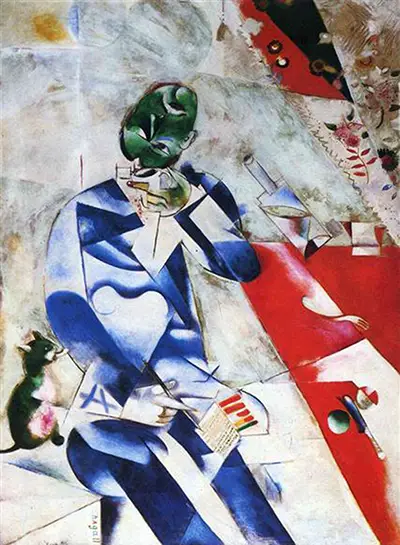He absorbed the influences around him there, and by the time of this oil on canvas study, had embraced Cubism, fragmenting his paintings into angles and jagged shapes, although he worked with a variety of styles throughout his life. The work, also known as Trois heures et demie (Le poète) or Half-Past Three (The Poet), was based on a more figurative and smaller rendition of his friend, the Russian poet Mazin, who was also a neighbour. This time, he broke up the subject and background into shapes and colours, perhaps suggesting Mazin's state of mind as he composed in the middle of the night. He has up-ended his friend's head, which could reference a Yiddish phrase fardreiter kop, meaning turned head, or disorientation.
This could convey the poet's tiredness, or could be intended to celebrate the heightened flow of creativity that often comes in the small hours. Chagall was born into a family of Hassidic Jews, so would have been familiar with this way of expressing a situation. The poet is grasping a cup of coffee, perhaps to keep him awake, although caffeine would hardly have calmed his thought processes. A pen hovers near the notebook on his knee, while cutlery, fruit and a bottle of wine appear to join in by turning and slanting on the table in front of him. In solidarity, the colour of the cat beside him has taken on the same green colour as that of Mazin's head.
During his four years in the French capital, Marc Chagall lived in Montparnasse, in La Ruche. Meaning the beehive in English, this was a community of artists that enabled him to absorb new styles, such as Cubism and Fauvism, and to mix with artists like Picasso, Matisse, Modigliani and the Delauneys. To his own work, he added the influence of Russian stories and religion, together with recollections of his own experiences, as can be seen here, with the painting's Yiddish connection. His early background meant that Chagall always felt something of an outsider, which perhaps kept his art fresh and open to new ideas.
He also had the opportunity to visit Parisian museums, taking in the displays of Impressionists and other painters. Even earlier influences were formed during art training in Saint Petersburg, and when working under Léon Bakst, who was associated with the Ballet Russes. The Poet or Half Past Three by Marc Chagall is in Philadelphia's Museum of Art, and the artist remains popular today. He continued to influence the development of modern art, and is still relevant in the contemporary art world.
